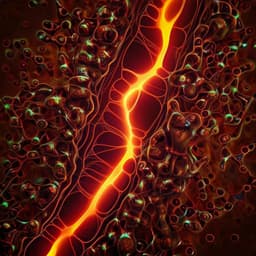
Agriculture
Long-read sequencing reveals genomic structural variations that underlie creation of quality protein maize
C. Li, X. Xiang, et al.
Discover how the mutation of o2 can double lysine content in maize endosperm, benefiting millions in developing nations. Researchers, including Changsheng Li and Xiaoli Xiang, unravel the genome of South African quality protein maize K0326Y and its intriguing relationship with various QTLs, potentially revolutionizing food sources.
Playback language: English
Introduction
Maize is a staple food crop globally, particularly vital as a protein source in developing nations. However, the zein proteins, the most abundant storage proteins in maize endosperm, are deficient in essential amino acids like lysine and tryptophan. This deficiency necessitates costly dietary supplementation. A natural high-lysine maize variant, the *o2* mutant, lacks a functional Opaque2 (O2) bZIP transcription factor, which regulates zein gene expression. While the *o2* mutation significantly increases lysine content by reducing zein production and increasing non-zein proteins, it results in a chalky, soft endosperm, negatively impacting grain quality, storage, and susceptibility to pests and diseases. Quality Protein Maize (QPM) addresses this by introducing *o2* modifiers (Mo2s) that restore kernel hardness while retaining the high lysine content of the *o2* mutant. This research aims to understand the genetic basis of this improvement by sequencing and analyzing the genome of a South African QPM line, K0326Y, using advanced long-read sequencing technology. The study focuses on identifying genomic structural variations and differentially expressed genes (DEGs) associated with Mo2s, providing valuable insights into the complex genetic mechanisms underlying QPM development and offering possibilities for improved maize breeding strategies.
Literature Review
Previous research has established that the vitreous kernel phenotype of QPM is determined by several unlinked loci. The challenge for maize breeders was to introduce multiple, unlinked Mo2s from tropical germplasm into temperate inbred lines while preserving the homozygous recessive *o2* locus. Studies have highlighted the 27-kD γ-zein (γ27), a cysteine-rich protein, as an important factor in endosperm modification in QPM. This protein plays a critical role in zein protein body (PB) formation and stabilization, influencing their accumulation in the rough endoplasmic reticulum. A major Mo2, *qy27*, resulting from a γ27 locus gene duplication, increases both 27-kD γ-zein transcript and protein levels, leading to increased PBs that coalesce around starch granules, forming vitreous endosperm during kernel desiccation. However, the precise mechanisms underlying Mo2 action beyond γ27 remained unclear. Previous studies had used linkage mapping and microarray hybridization to identify some candidate genes associated with Mo2 QTLs but lacked the complete genomic context necessary for a thorough understanding.
Methodology
The researchers used a combination of advanced sequencing technologies to assemble the genome of the South African QPM line K0326Y. This included PacBio single-molecule real-time (SMRT) sequencing, Illumina paired-end sequencing, and BioNano optical mapping. The long-read sequencing data from PacBio, with an N50 read length of 16.6 kb and 139-fold coverage, allowed for the resolution of repetitive sequences and the creation of highly contiguous genome assemblies. The Illumina data (132.5 Gb PacBio consensus sequences and 217.5 Gb high-quality Illumina paired-end reads) were used for error correction and improved assembly quality. BioNano optical mapping (389.3 Gb BioNano molecules) provided additional information for scaffolding and gap closure. The assembled genome was validated using a high-density maize pan-genome genetic map containing ~4.4 million genotype-by-sequencing (GBS) tags. Genome completeness and accuracy were assessed using BUSCO analysis and Illumina read mapping. Repeat analysis was performed using both homology-based and de novo approaches. Gene models were predicted using a combination of evidence-based and ab initio methods, incorporating PacBio Iso-Seq data (1,618,691 high-quality full-length non-chimeric reads). Comparative genomics was conducted comparing K0326Y to the well-annotated B73 and Mo17 maize genomes to identify structural variations (SNPs, InDels, and presence/absence variations). To map Mo2 QTLs, the researchers performed a bulked segregant analysis (BSA-seq) using an F2 population derived from a cross between K0326Y and W64Ao2. RNA-seq was employed to analyze gene expression differences between QPM and *o2* endosperms at 16 days after pollination (DAP), identifying DEGs and relating them to the mapped QTLs. The study also involved detailed analysis of specific candidate genes, including *o10*, *y27*, *Pfpa3.4*, *SR45a*, and *ERDJ3A*, examining their structural variations and expression levels to assess their potential roles in Mo2 function and vitreous endosperm formation.
Key Findings
The study successfully assembled a high-quality genome for the QPM line K0326Y, achieving a contig N50 of 7.77 Mb—significantly higher than previously sequenced maize genomes (B73 and Mo17). The high contiguity allowed for detailed analysis of repetitive regions and structural variations. The genome showed a high percentage (83.32%) of repetitive elements, mostly retrotransposons. A total of 38,238 genes were annotated. Comparative genomics revealed numerous SNPs, InDels, and structural variations (including two large inversions specific to K0326Y) when compared to B73 and Mo17. A substantial number of presence/absence variations (PAVs) were identified, affecting 3568 genes, many of which were upregulated in QPM endosperm and enriched in pathways like starch biosynthesis and ATPase activity. Bulked segregant analysis identified Mo2 QTLs on chromosomes 1, 6, 7, and 9. RNA-seq analysis identified 1791 DEGs overlapping between comparisons of K0326Y/W64Ao2 and CM105Mo2/CM105o2. These genes were significantly enriched in functions related to chaperone binding, unfolded protein binding, protein folding, and stress responses. Detailed analysis of candidate genes revealed structural variations and altered expression potentially contributing to the QPM phenotype. The *qy27* locus showed a tandem duplication with SNPs differentiating the gene copies. The *Pfpa3.4* gene exhibited a Helitron insertion in the promoter in K0326Y, strongly associated with increased expression and the vitreous phenotype. *SR45a* and *ERDJ3A*, closely linked to a QTL on chromosome 9, showed elevated expression in QPM and contained structural variations.
Discussion
The findings of this study significantly advance our understanding of the genetic basis of QPM development. The high-quality K0326Y genome assembly, combined with detailed analyses of structural variations and gene expression, has identified several key candidate genes and associated mechanisms. The increased expression of genes involved in glycolysis, particularly *Pfpa3.4*, suggests a role in mitigating the energy deficit caused by the *o2* mutation. The upregulation of HSPs and *ERDJ3A* points to a robust unfolded protein response in QPM, helping manage the protein folding stress associated with the *o2* mutant. The identification of multiple Mo2 loci highlights the polygenic nature of the vitreous phenotype. The presence of structural variations like tandem duplications, insertions, and deletions in candidate genes indicates the important role of transposable elements in driving phenotypic diversity in maize. These findings directly address the research question by identifying genomic locations and associated genes responsible for the QPM phenotype. The significant improvement in QPM genome sequencing opens possibilities for marker-assisted selection and accelerated breeding efforts. The knowledge gained contributes significantly to the ongoing effort of improving maize nutritional value and crop yield.
Conclusion
This research provides a comprehensive genomic resource for understanding the creation of quality protein maize. The high-quality genome assembly of the QPM line K0326Y, coupled with QTL mapping and RNA-seq analysis, has revealed a complex interplay of structural variations and gene expression changes underlying the vitreous endosperm phenotype. The identification of candidate genes like *Pfpa3.4*, *SR45a*, and *ERDJ3A*, along with the elucidation of their associated structural variants, provides significant targets for future breeding efforts. Future research could focus on functional validation of candidate genes, exploring the regulatory networks controlling their expression, and employing genome editing technologies to further enhance QPM traits. This comprehensive study lays a foundation for future genetic improvement of maize, benefiting food security, particularly in developing countries.
Limitations
While this study provides significant insights into QPM development, some limitations should be noted. The analysis focuses on a single QPM line (K0326Y), limiting the generalizability of findings to other QPM varieties. The study primarily focuses on endosperm development at a single time point (16 DAP), potentially overlooking dynamic changes in gene expression during other stages of kernel development. Although the authors identified several candidate genes, functional validation through targeted mutagenesis is still needed to definitively confirm their causative roles. The use of F2 population in the QTL-seq analysis might lead to some uncertainty in precise QTL mapping, due to the limited number of recombination events. Finally, the environmental factors influence on the expression of genes related to QPM development are not extensively studied in this paper.
Related Publications
Explore these studies to deepen your understanding of the subject.







